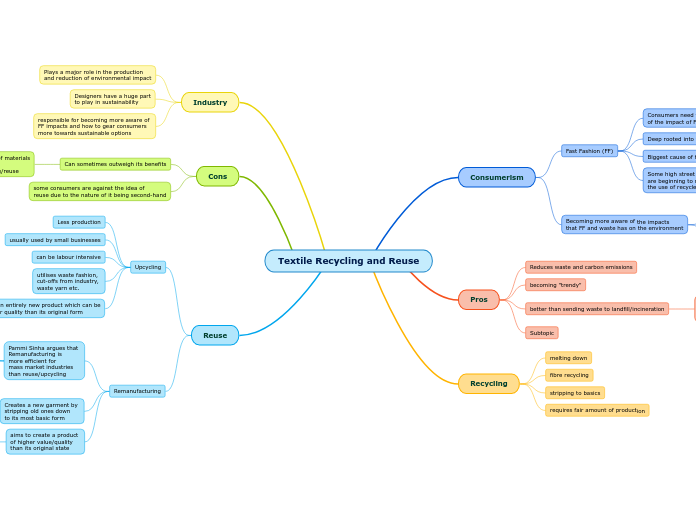Textile Recycling and Reuse
Consumerism
Fast Fashion (FF)
Consumers need to be aware
of the impact of FF
Deep rooted into the fashion world
Biggest cause of fashion/textile waste
Some high street brands
are beginning to move towards
the use of recycled materials & fibres
Becoming more aware of the impacts
that FF and waste has on the environment
consumers are gearing more
towards eco-friendly & recycled
fashion & textiles
Tends to be the younger generation
Pros
Reduces waste and carbon emissions
becoming "trendy"
better than sending waste to landfill/incineration
It is argued that reuse is better
than recycling since it has a lower
production rate
Subtopic
Recycling
melting down
fibre recycling
stripping to basics
requires fair amount of production
Industry
Plays a major role in the production
and reduction of environmental impact
Designers have a huge part
to play in sustainability
responsible for becoming more aware of
FF impacts and how to gear consumers
more towards sustainable options
Cons
Can sometimes outweigh its benefits
i.e. transportation of materials
can outweigh the
benefits of recycling/reuse
some consumers are against the idea of
reuse due to the nature of it being second-hand
Reuse
Upcycling
Less production
usually used by small businesses
can be labour intensive
utilises waste fashion,
cut-offs from industry,
waste yarn etc.
creates an entirely new product which can be
of a lower quality than its original form
Remanufacturing
Pammi Sinha argues that
Remanufacturing is
more efficient for
mass market industries
than reuse/upcycling
less labour intensive
quicker production rate
"higher form of reuse that
focuses on value-added
recovery"
Creates a new garment by
stripping old ones down
to its most basic form
aims to create a product
of higher value/quality
than its original state
aims to extend the warranty/
lifespan of materials & fibres
